Charles E W Bean, Diaries, AWM38 3DRL 606/45/1 - June 1916 - Part 9
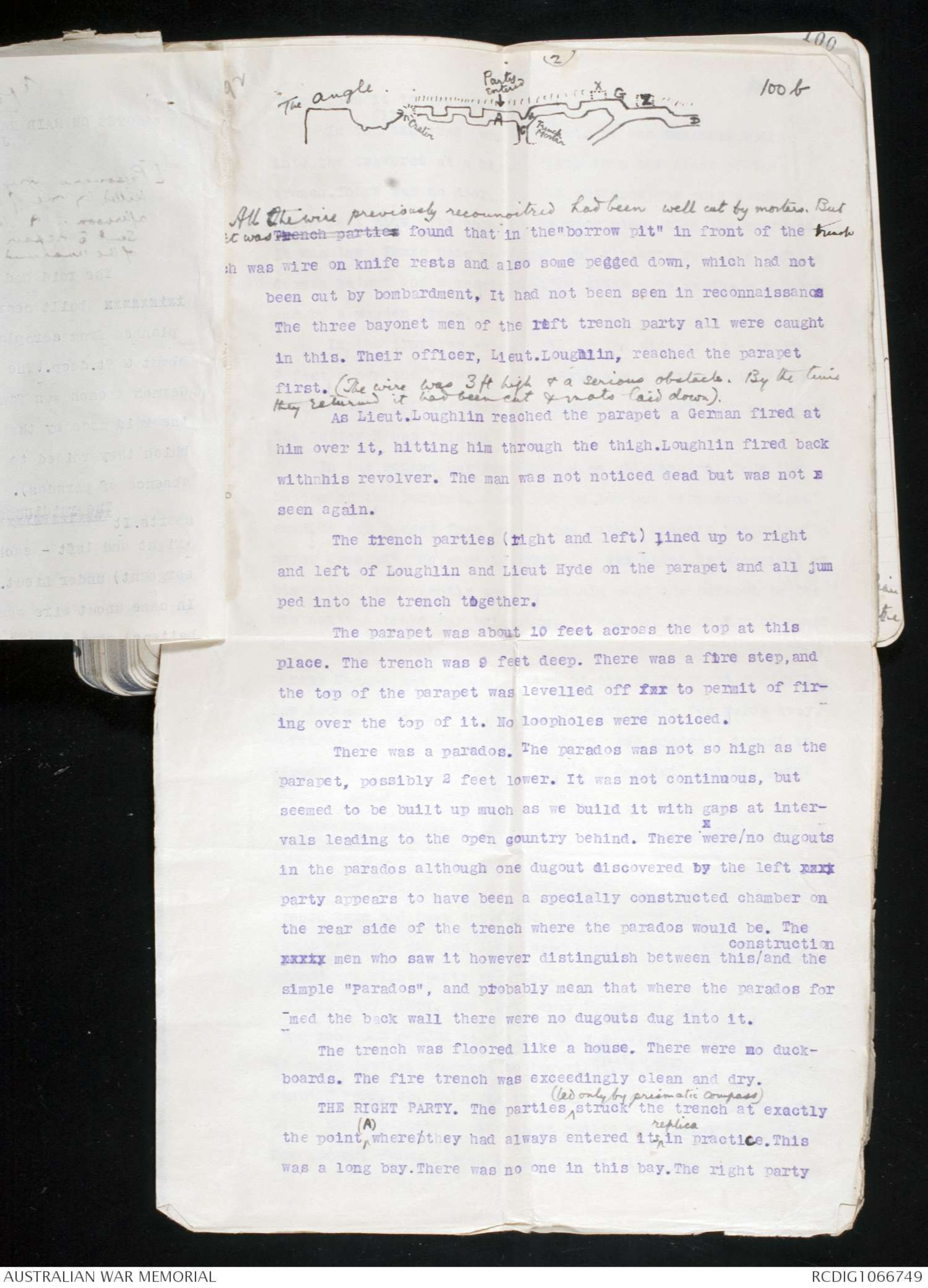
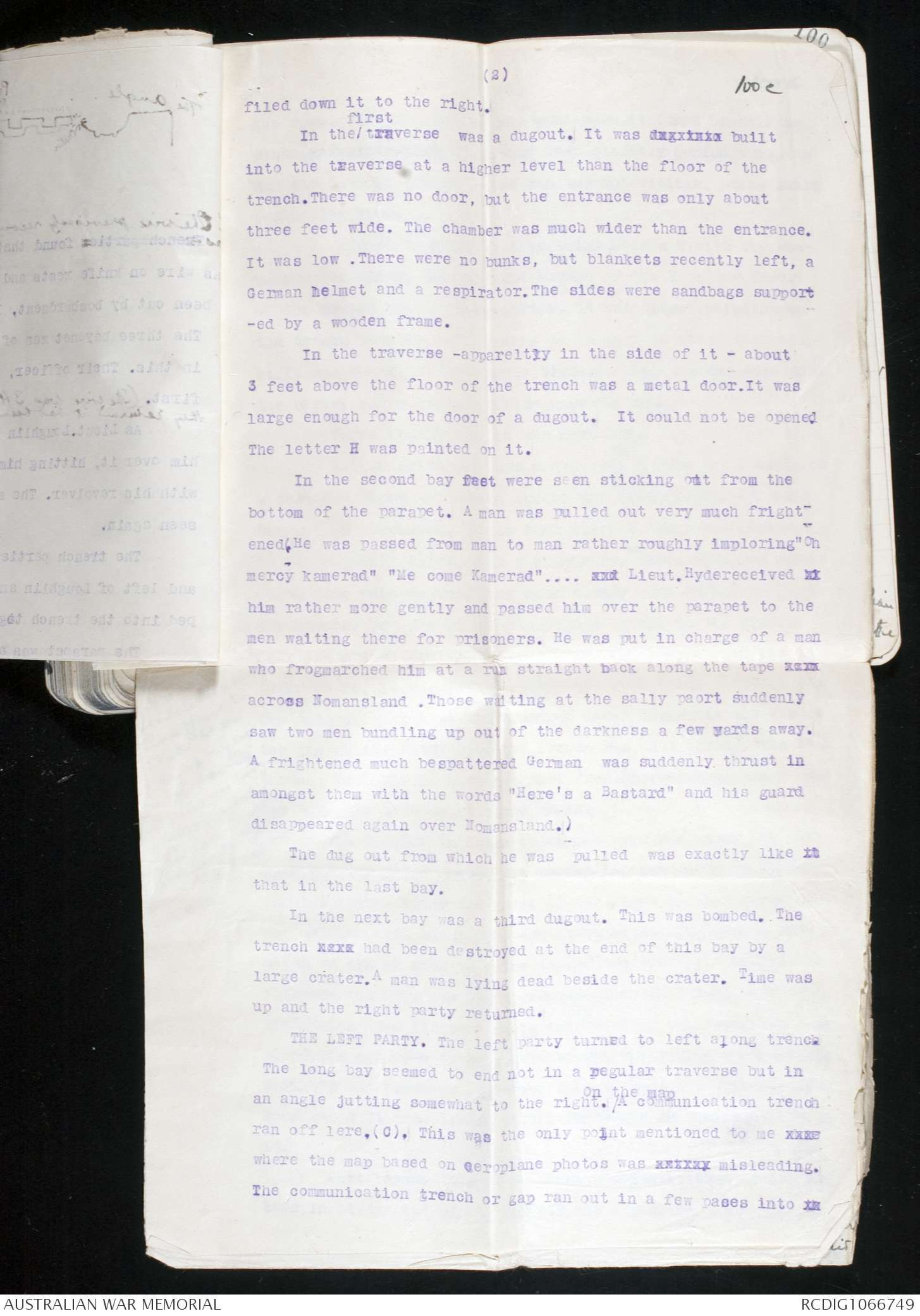
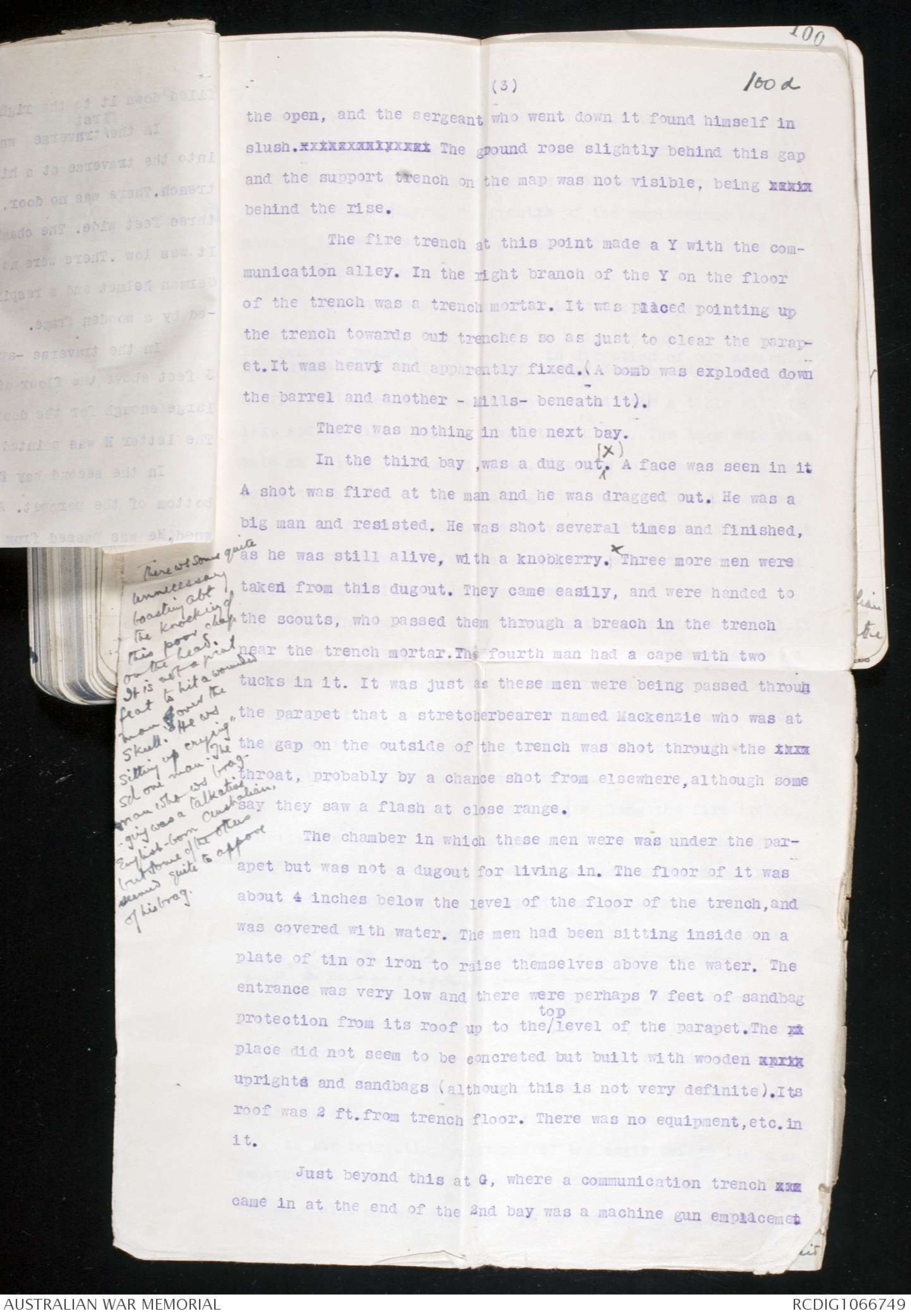
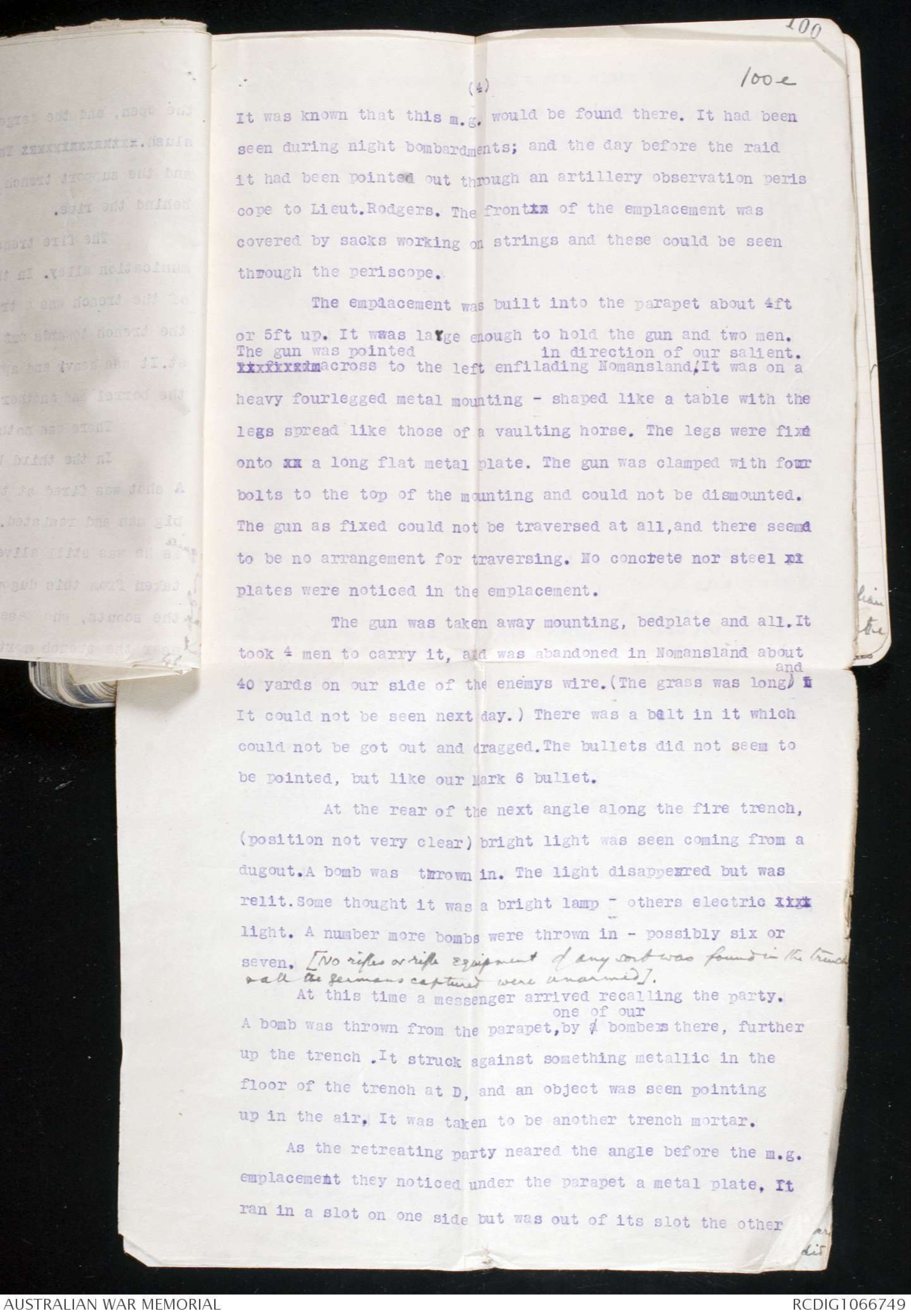
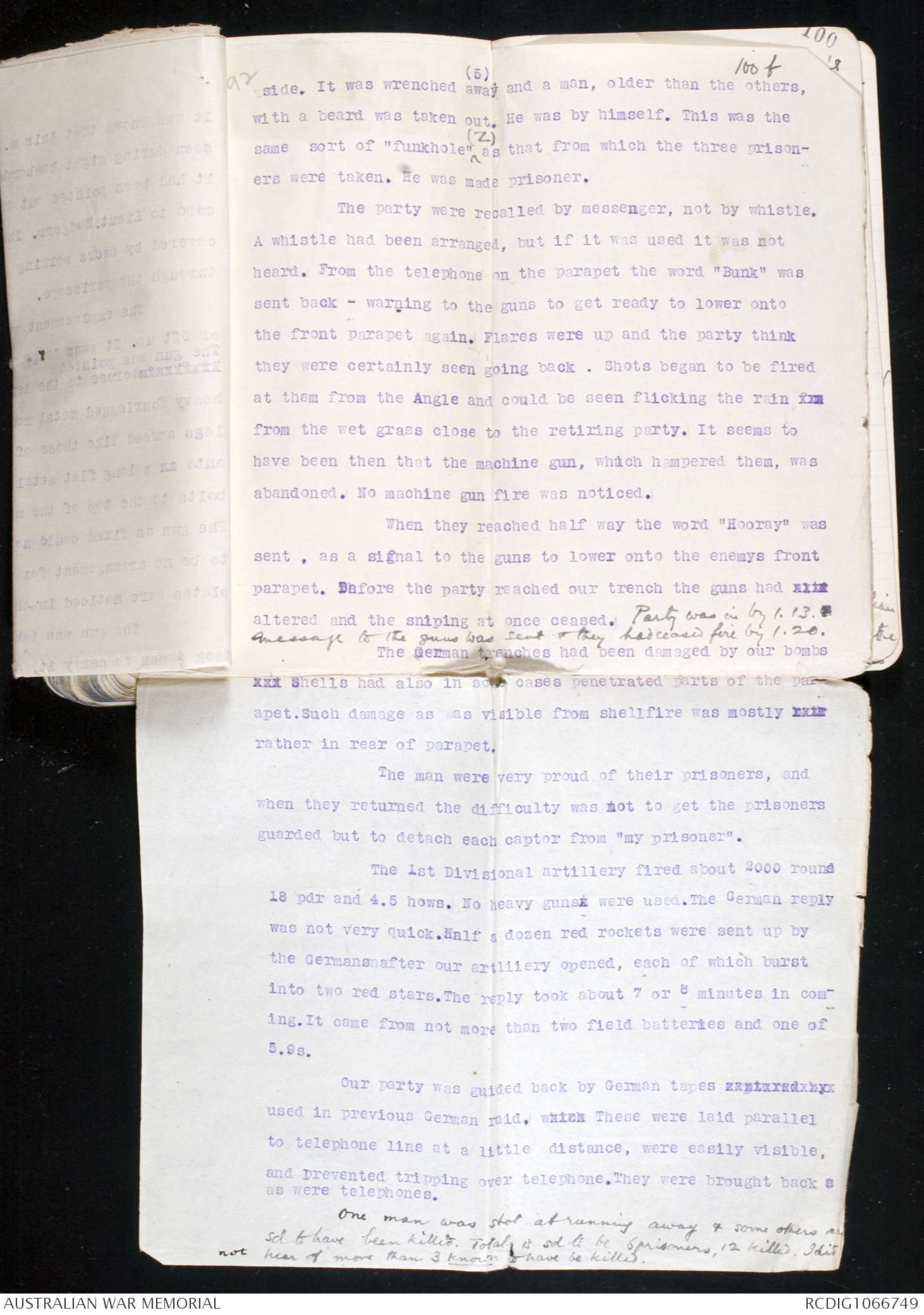

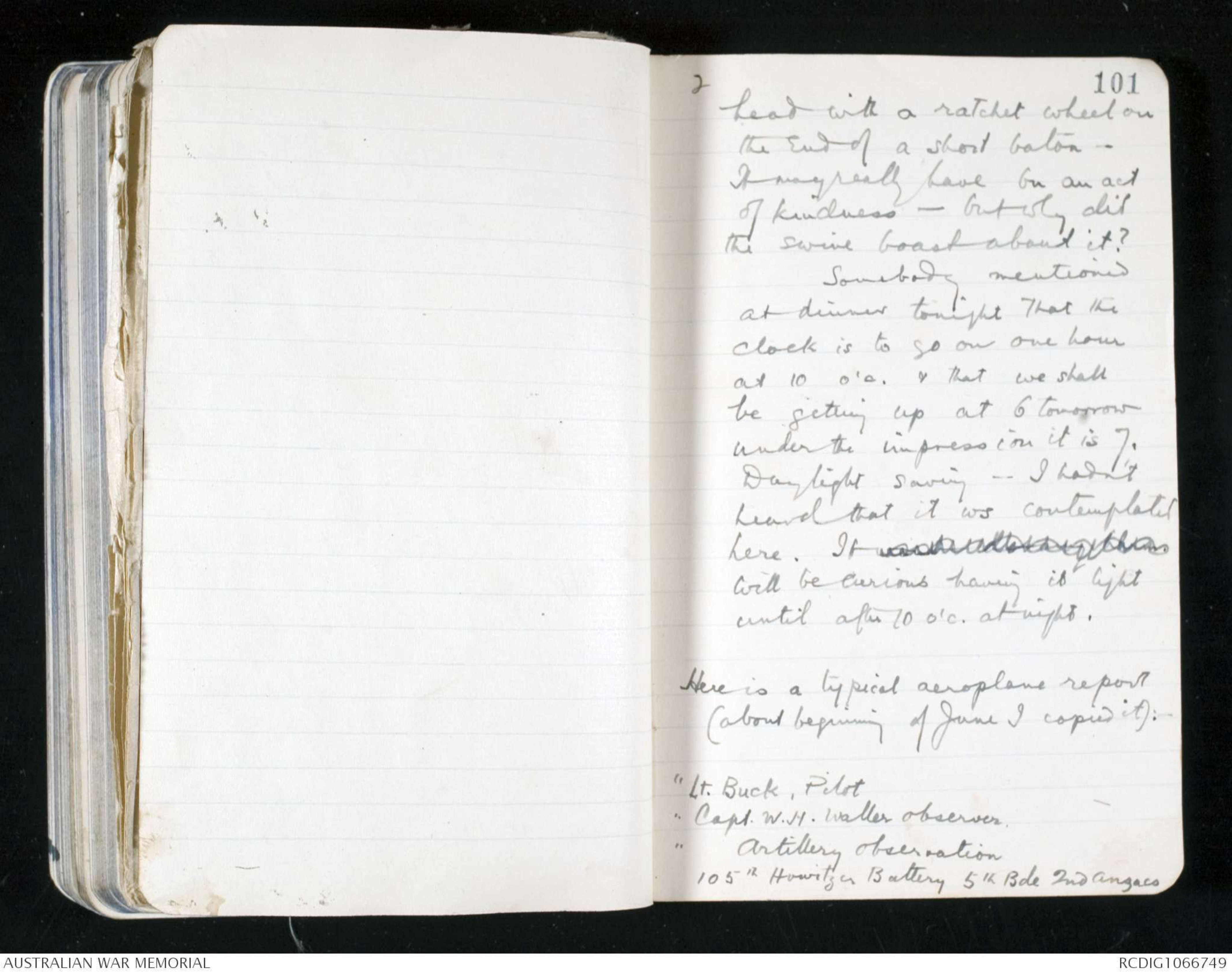
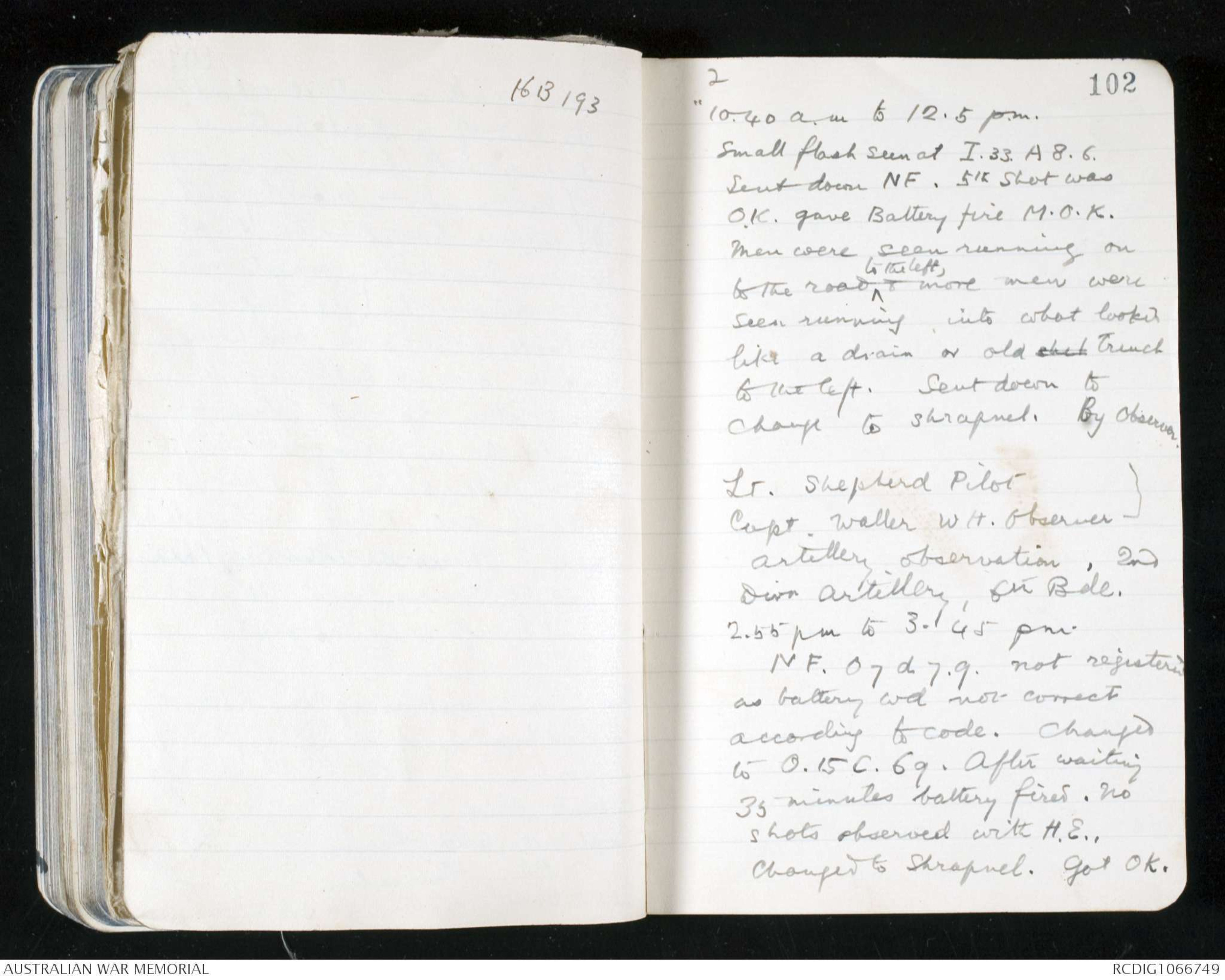
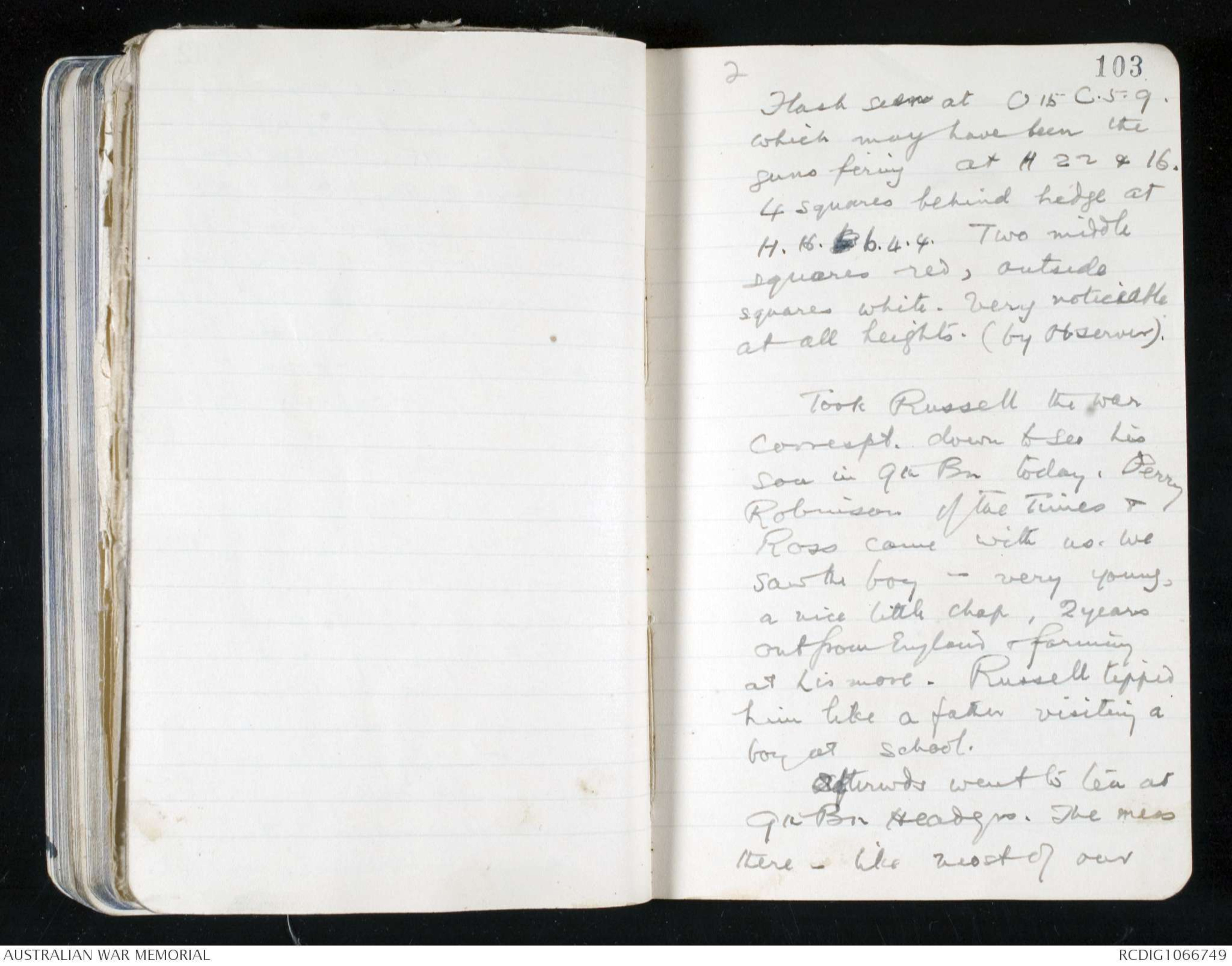
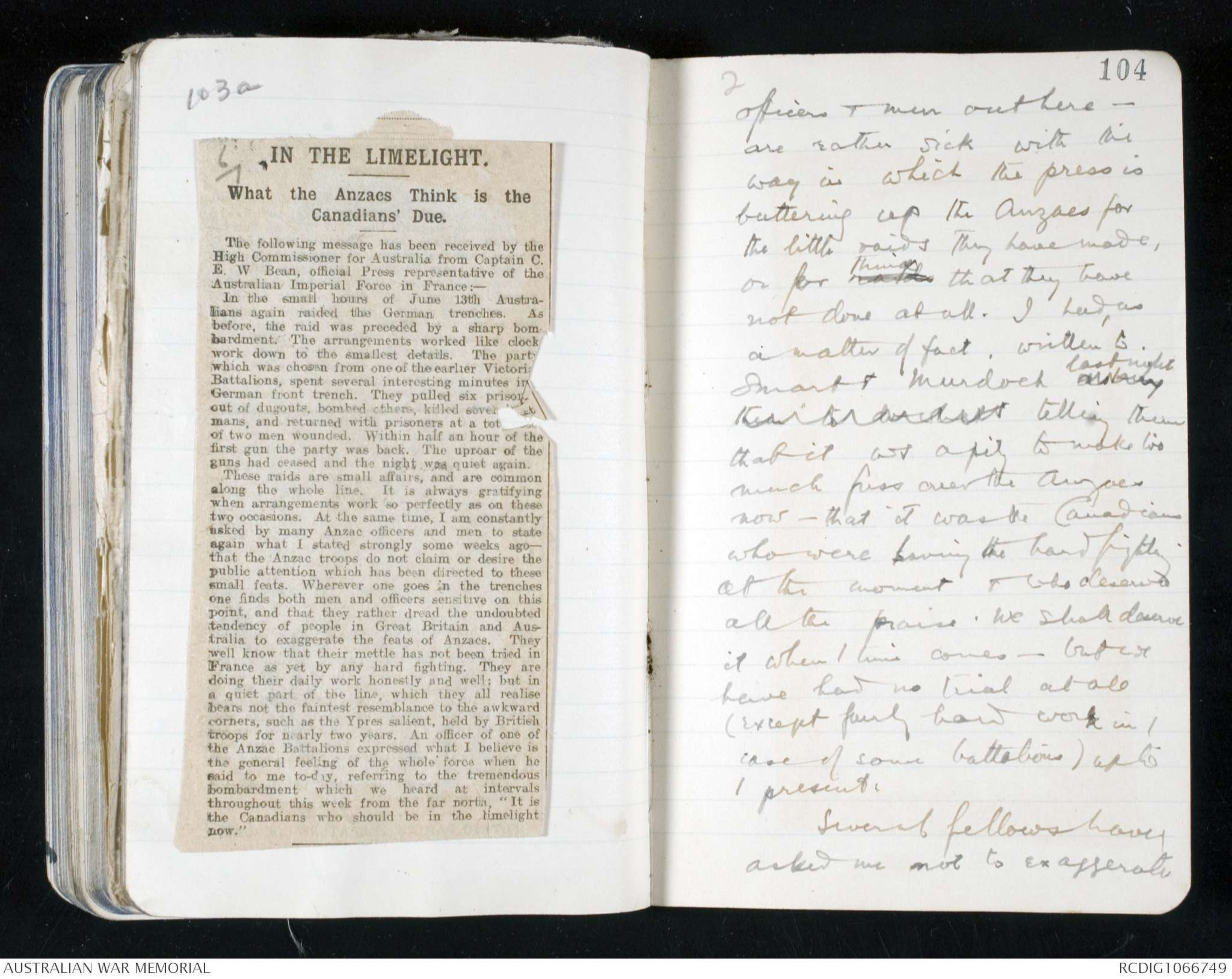
(2)
100 b
Hand drawn diagram – see original
All the wire previously reconnoitred had been well cut by mortars. But
it was French parties found that in the "borrow pit" in front of the trench
h was wire on knife rests and also some pegged down, which had not
been cut by bombardment. It had not been seen in reconnaisance
The three bayonet men of the reft trench party all were caught
in this. Their officer, Lieut. Loughlin, reached the parapet
first. (The wire was 3 ft high & a serious obstacle. By the time
they returned it had been cut & mats laid down).
As Lieut.Loughlin reached the parapet a German fired at
him over it, hitting him through the thigh.Loughlin fired back
with his revolver. The man was not noticed dead but was not x
seen again.
The trench parties (right and left) lined up to right
and left of Loughlin and Lieut Hyde on the parapet and all jumped
into the trench together.
The parapet was about 10 feet across the top at this
place. The trench was 9 feet deep. There was a fire step, and
the top of the parapet was levelled off for to permit of firing
over the top of it. No loopholes were noticed.
There was a parados. The parados was not so high as the
parapet, possibly 2 feet lower. It was not continuous, but
seemed to be built up much as we build it with gaps at intervals
leading to the open country behind. There were no dugouts
in the parados although one dugout discovered by the left xxxx
party appears to have been a specially constructed chamber on
the rear side of the trench where the parados would be. Thexxxxx men who saw it however distinguish between this ^construction and the
simple "Parados", and probably mean that where the parados formed
the back wall there were no dugouts dug into it.
The trench was floored like a house. There were no duckboards.
The fire trench was exceedingly clean and dry.
THE RIGHT PARTY. The parties ^(led only by prismatic compass) struck the trench at exactly
the point ^ (A) whereb they had always entered its ^replica in practice. This
was a long bay. There was no one in this bay. The right party
(2)
100c
filed down it to the right.
In the ^first traverse was a dugout. It was xxxxx built
into the traverse at a higher level than the floor of the
trench.There was no door, but the entrance was only about
three feet wide. The chamber was much wider than the entrance.
It was low .There were no bunks, but blankets recently left, a
German helmet and a respirator.The sides were sandbags supported
by a wooden frame.
In the traverse -appareltly in the side of it - about
3 feet above the floor of the trench was a metal door.It was
large enough for the door of a dugout. It could not be opened
The letter H was painted on it.
In the second bay feet
were seen sticking out from the
bottom of the parapet. A man was pulled out very much frightened(.
He was passed from man to man rather roughly imploring"Oh
mercy kamerad" "Me come Kamerad" ....xxx Lieut.Hydereceived xx
him rather more gently and passed him over the parapet to the
men waiting there for prisoners. He was put incharge of a man
who frogmarched him at a run straight back along the tape xxx
across Nomansland Those waiting at the sally port suddenly
saw two men bundling up out of the darkness a few yards away.
A frightened much bespattered German was suddenly thrust in
amongst them with the words "Here's a Bastard" and his guard
disappeared again over Nomansland.)
The dug out from which he was pulled was exactly like xx
that in the last bay.
In the next bay was a third dugout. This was bombed. The
trench xxx had been destroyed at the end of this bay by a
large crater.A man was lying dead beside the crater. Time was
up and the right party returned.
THE LEFT PARTY. The left party turned to left along trench.
The long bay seemed to end not in a regular traverse but in
an angle jutting somewhat to the right. ^On the map a communication trench
ran off here.(C). This was the only point mentioned to me xxx
where the map based on aeroplane photos was xxxxxx misleading.
The communication trench or gap ran out in a few paces into xx
(3)
100d
the open, and the sergeant who went down it found himself in
slush. xxxxxxxxx The ground rose slightly behind this gap
and the support trench on the map was not visible, being xxxx
behind the rise.
The fire trench at this point made a Y with the communication
alley. In the right branch of the Y on the floor
of the trench was a trench mortar. It was placed pointing up
the trench towards our trenches so as just to clear the parapet.
It was heavy and apparently fixed.(A bomb was exploded down
the barrel and another - Mills- beneath it).
There was nothing in the next bay.
In the third bay was a dug out^(X). A face was seen in it.
A shot was fired at the man and he was dragged out. He was a
big man and resisted. He was shot several times and finished,
as he was still alive. with a knobkerry. Three more men were
taken from this dugout. They came easily, and were handed to
the scouts, who passed them through a breach in the trench
near the trench mortar. The fourth man had a cape with two
tucks in it. It was just as these men were being passed through
the parapet that a stretcherbearer named Mackenzie who was at
the gap on the outside of the trench was shot through the xxxx
throat, probably by a chance shot from elsewhere, although some
say they saw a flash at close range.
[*There was some quite
unnecessary
boasting abt
the knocking of
this poor chap
on the head.
It is not a great
feat to hit a wounded
man xx over the
skull. "He ws
sitting up crying"
sd one man. The
man who ws bragging
was a talkative
English-born Australian,
but some of the others
seemed quite to approve
of his brag.*]
The chamber in which these men were was under the parapet
but was not a dugout for living in. The floor of it was
about 4 inches below the level of the floor of the trench, and
was covered with water. The men had been sitting inside on a
plate of tin or iron to raise to raise themselves above the water. The
entrance was very low and there were perhaps 7 feet of sandbag
protection from it roof up to the ^top level of the parapet. The xx
place did not seem to be concreted but built with wooden xxxxx
uprights and sandbags(although this is not very definite).Its
roof was 2 ft. from trench floor. There was no equipment,etc. in
it.
Just beyond this at G, where a communication trench xxx
came in at the end of the 2nd bay was a machine gun emplacemet
(4)
100 e
It was known that this m.g. would be found there. It had been
seen during night bombardments; and the day before the raid
it had been pointed out through an artillery observation periscope
to Lieut.Rodgers. The frontxx of the emplacement was
covered by sacks working on strings and these could be seen
through the periscope.
The emplacement was built into the parapet about 4ft
or 5ft up. It was large enough to hold the gun and two men.xxxxx The gun was pointed across to the left enfilading Nomansland ^in direction of our salient. It was on a
heavy fourlegged metal mounting - shaped like a table with the
legs spread like those of a vaulting horse. The legs were fixd
onto xx a long flat metal plate. The gun was clamped with four
bolts to the top of the mounting and could not be dismounted.
The gun as fixed could not be traversed at all,and there seemd
to be no arrangement for traversing.No concrete or steel xx
plates were noticed in the emplacement.
The gun was taken away mounting, bedplate and all.It
took 4 men to carry it, and was abandoned in Nomansland about
40 yards from our side of the enemys wire. (The gun was long ^and x
It could not be seen next day. ) There was a belt in it which
could not be got out and dragged. The bullets did nor seem to
be pointed, but like our mark 6 bullet.
At the rear of the next angle along the fire trench,
(position not very clear) bright light was seen coming from a
dugout.A bomb was thrown in. The light disappeared but was
relit. Some thought it was a bright lamp - others electric xxxx
light. A number more bombs were thrown in - possibly six or
seven. [No rifles or rifle equipment of any sort was found in the trench
& all the Germans captured were unarmed].
At this time a messenger arrived recalling the party.
A bomb was thrown from the parapet, by a one of our bombers there, further
up the trench .It struck against something metallic in the
floor of the trench at D, and an object was seenpointing
up in the air. It was taken to be another trench mortar.
As the retreating party neared the angle before the m.g.
emplacement they noticed under the parapet a metal plate. It
ran in a slot on one side but was out of its slot the other
92
(5)
100f
side. It was wrenched away and a man, older than the others,
with a beard was taken out. He was by himself. This was the
same sort of "funkhole" ^(Z) as that from which the three prisoners
were taken. He was made prisoner.
The party was recalled by messenger, not by whistle.
A whistle had been arranged, but if it was used it was not
heard. From the telephone on the parapet the work "Bunk" was
sent back - warning to the guns to get ready to lower onto
the front parapet again. Flares were up and the party think
they were certainly seen going back . Shots began to be fired
at them from the Angle and could be seen flicking the rain xxx
from the wet grass close to the retiring party. It seems to
have been then that the machine gun, which hampered them, was
abandoned. No machine gun fire was noticed.
When they reached halfway the word "Hooray" was
sent , as a signal to the guns to lower onto enemys front
parapet. Before the party reached our trench the guns had xxxx
altered and the sniping at once ceased. Party was in by 1.13. x
A message to the guns was sent & they had ceased fire by 1.20.
The German trenches had been damaged by our bombsxxx Shells had also in some cases penetrated parts of the parapet.
Such damage as was visible from shellfire was mostly xxxx
rather in rear of the parapet.
The men were very proud of their prisoners, and
when they returned the difficulty was not to get the prisoners
guarded but to detach each captor from "my prisoner".
The 1st Divisional artillery fired about 2000 round
18 pdr and 4.5 hows. No heavy gunsx were used.The German reply
was not very quick.Half a dozen red rockets were sent up by
the Germans after our artillery opened, each of which burst
into two red stars.The reply took about 7 or 8 minutes in coming.
It came from not more than two field batteries and one of
5.9s.
Our party was guided back by German tapes xxxxxxx
used in previous German raid. which These were laid parallel
to telephone line at a little distance, were easily visible,
and prevented tripping over telephone. They were
brought back x
as were telephones.
One man was shot at running away & some others are
sd to have been killed. Total is sd to be 5 prisoners, 12 killed. I did
not hear of more than 3 known to have be killed.
2
100
wondering why she hasn't
heard from him for two days,
I always hope to goodness
that the man ws captured
alive; & was not that poor
fighting beggar, for example, the
other day whom the talkative
English-Australian finished
off with a knobkerry. He ws
a big man - they sd - &
fought. (He seems to have bn
/ only one who did fight). They
fired first at his face - then
dragged him out - & as
he resisted Sergt — quite
rightly shot him twice -
probably thro' the head. They
left him there in / trench &
went on. But when they
came back he was still
there sitting up, crying - so
the talkative English Australian
hit him several times on the
2
101
head with a ratchet wheel on
the end of a short baton -
It may really have bn an act
of kindness - but why did
the swine boast about it?
Somebody mentioned
at dinner tonight that the
clock is to go on one hour
at 10 o'c. & that we shall
be getting up at 6 tomorrow
under the impression it is 7.
Daylight saving - I hadn't
heard that it ws contemplated
here. It xxxxxxxxxxxxxxxx
will be curious having it light
until after 10 o'c. at night.
Here is a typical aeroplane report
(about beginning of June I copied it): -
" Lt. Buck , Pilot
" Capt. W.H. Waller observer.
" Artillery observation
105th Howitzer Battery 5th Bde 2nd Anzacs
16 B 193
2
102
" 10.40 a.m to 12.5 p.m.
Small flash seen at I. 33. A 8. 6.
Sent down NF. 5th shot was
O.K. gave Battery fire M.O.K.
Men were seen running on
to the road ^to the left, & more men were
seen running into what looked
like a drain or old shel trench
to the left. Sent down to
change to shrapnel. By observer.
Lt. Shepherd Pilot }
Capt. Waller W.H. Observer }
artillery observation, 2nd
Divn Artillery, 6th Bde.
2.55 pm to 3.45 pm.
N F. O 7 d 7. 9. not registered
as battery wd not correct
according to code. Changed
to O. 15 C. 69. After waiting
35 minutes battery fired. No
shots observed with H.E.,
changed to shrapnel. Got OK.
2
103
Flash seen at O 15 C. 5. 9.
which may have been the
guns firing at H 22 & 16.
4 squares behind hedge at
H. 16. xx b. 4. 4. Two middle
squares red, outside
squares white. Very noticeable
at all heights. (by observer).
Took Russell the war
correspt. down to see his
son in 9th Bn today. Perry
Robinson of The Times &
Ross came with us. We
saw the boy - very young,
a nice little chap, 2 years
out from England & farming
at Lismore. Russell tipped
him like a father visiting a
boy at school.
Afterwds went to tea at
9th Bn Headqrs. The mess
there - like most of our
103a
6 IN THE LIMELIGHT.
_______
What the Anzacs Think is the
Canadians' Due.
______
The following message has been received by the
High Commissioner for Australia from Captain C.
E. W Bean, official Press representative of the
Australian Imperial Force in France:—
In the small hours of June 13th Australians
again raided the German trenches. As
before, the raid was preceded by a sharp bombardment.
The arrangements worked like clock
work down to the smallest details. The party
which was chosen from one of the earlier Victoria
Battalions, spent several interesting minutes in
German front trench. They pulled six prison
out of dugouts, bombed others, killed sever
mans, and returned with prisoners at a tot
of two men wounded. Within half an hour of the
first gun the party was back. The uproar of the
guns had ceased and the night was quiet again.
These raids are small affairs, and are common
along the whole line. It is always gratifying
when arrangements work so perfectly as on these
two occasions. At the same time, I am constantly
asked by many Anzac officers and men to state
again what I stated strongly some weeks ago -
that the Anzac troops do not claim or desire the
public attention which has been directed to these
small feats. Wherever one goes in the trenches
one finds both men and officers sensitive on this
point, and that they rather dread the undoubted
tendency of people in Great Britain and Australia
to exaggerate the feats of Anzacs. They
well know that their mettle has not been tried in
France as yet by any hard fighting. They are
doing their daily work honestly and well; but in
a quiet part of the line, which they all realise
bears not the faintest resemblance to the awkward
corners, such as the Ypres salient, held by British
troops for nearly two years. An officer of one of
the Anzac Battalions expressed what I believe is
the general feeling of the whole force when he
said to me to-day, referring to the tremendous
bombardment which we heard at intervals
throughout this week from the far north, "It is
the Canadians who should be in the limelight
now."
2
104
officers & men out here -
are rather sick with the
way in which the press is
buttering up the Anzacs for
the little raids they have made,
or for raids things that they have
not done at all. I had, as
a matter of fact, written to
Smart & Murdoch asking last nightthem to do what I telling them
that it was a pity to make too
much fuss over the Anzacs
now - that it was the Canadians
who were having the hard fighting
at the moment & who deserved
all the praise. We shall deserve
it when / time comes - but we
have had no trial at all
(except fairly hard work in /
case of some battalions) up to
/ present.
Several fellows have
asked me not to exaggerate
 Sam scott
Sam scottThis transcription item is now locked to you for editing. To release the lock either Save your changes or Cancel.
This lock will be automatically released after 60 minutes of inactivity.